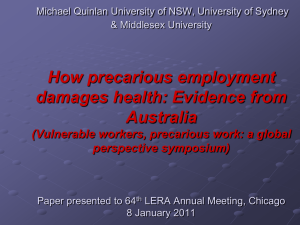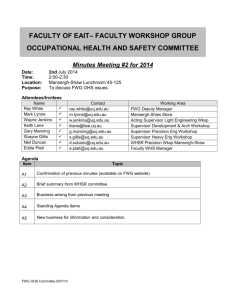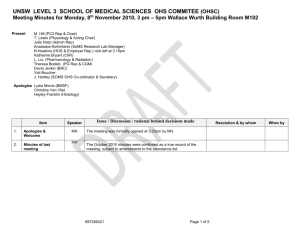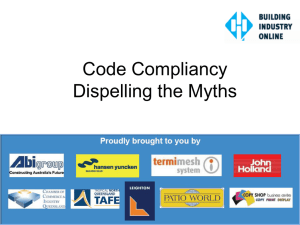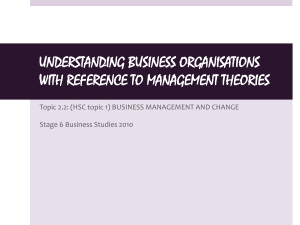Bohle, P. & Quinlan, M. Contingent work and occupational stress
advertisement
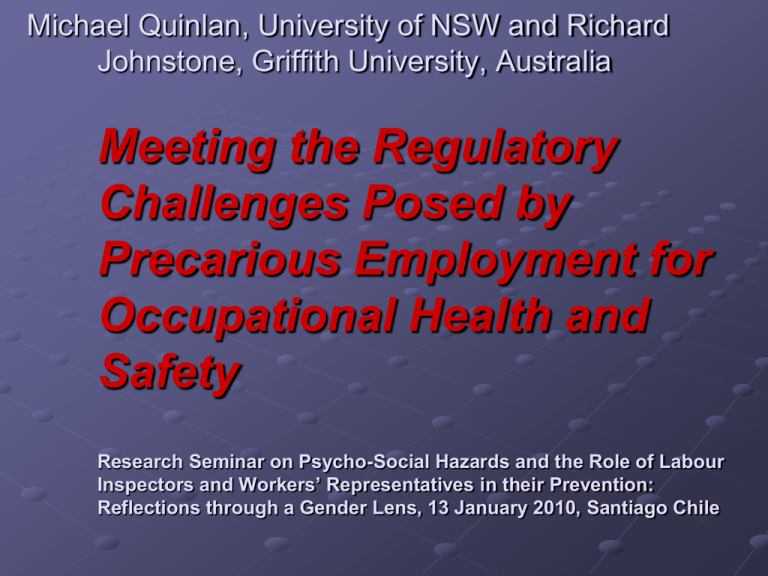
Michael Quinlan, University of NSW and Richard Johnstone, Griffith University, Australia Meeting the Regulatory Challenges Posed by Precarious Employment for Occupational Health and Safety Research Seminar on Psycho-Social Hazards and the Role of Labour Inspectors and Workers’ Representatives in their Prevention: Reflections through a Gender Lens, 13 January 2010, Santiago Chile Overview Changes to work and OHS effects of this How best to explain these effects Briefly identify historical parallels that should inform policy makers Examine existing policy responses and indentify a framework for future policy developments Changes to Work Organisation & Job Insecurity (1975-2008) Repeated downsizing, restructuring & work reorganisation (work intensification via task changes, multi-tasking etc) Outsourcing/growing use subcontractors/labour leasing (means privatisation in public sector) & franchising Decline in permanent jobs Changes to Work Organisation & Job Insecurity continued Corresponding growth of temporary, fixed contract & leased jobs as well as home-based work & telework More multiple jobholding, long shifts, unpaid overtime/presenteeism Increased immigration/use of temporary guestworkers Looming global recession likely to exacerbate these trends Review of research on OHS effects of changing work arrangements Published international research 1966-2008 (IJHS) weak & ‘repeat’ studies culled Measures include injury rates, disease, hazard exposures, violence, mental health, knowledge and compliance 86 studies of job insecurity/downsizing (73 or 85% found adverse OHS effects) Studies using mental health/psychosocial measures common Few studies on effects on bullying and occupational violence Growing number of studies look at work life balance/hours Gender imbalance remains in terms of measuring effects Public health effects (healthcare) and job ‘quality’ Review of research on OHS effects of changing work arrangements cont. 25 studies of outsourcing/subcontracting & home-based work (23 or 92% found adverse effect, 2 mixed) Mostly injury focused & not enough on psychosocial Few studies deal with bullying/occupational violence Research has stalled & major areas re women neglected (homecare) Permanent part-time workers – very few studies/mixed 22 studies of temporary work/agency work (17 or 77% found adverse effect) Psychosocial outcomes more mixed (different trajectories) Number of studies is mounting but still not enough on women Exposure effects often overlooked Unwanted sexual advances higher (LaMontagne et al 2009) Link between precarious employment & psychosocial risks are not new ‘Sweating and Suicide’ (Lancet April 1888) reported woman acquitted from attempting to commit suicide at Manchester City Police Court ‘though her only excuse was the extremely low wages she earned when working for a sweater. During the whole of the previous week she had worked as a costume finisher from half-past eight in the morning till seven in the evening, and yet only earned 2s. 2d. She lived on tea and bread, and out of these wages 6d.was deducted in consideration of the hot water supplied for her tea! Then she had to repay a loan of 6d. to the forewoman. With the remaining 1s. 2d she had to meet her rent, which amounted to 2s 6d a week.’ Why does precarious employment damage psychosocial wellbeing? Work intensification economic vulnerability Lack of dignity/powerlessness Commodification of social interaction conducive to more autocratic & ‘masculine’ management forms limited legal rights/access Job insecurity/life insecurity Poor work/family balance How restructuring and downsizing can alter work systems, process & environment Reallocation of tasks/loads to smaller staff pool Changes to job descriptions, multi-tasking Changes to workplace facilities (space etc) Changes to training, supervision (hard HR) How restructuring and downsizing can alter work systems continued Disorganisation (communication, isolation etc) Changes to hours (paid/unpaid), leave access Changes to grievance/consultation mechanisms Uncertainty and insecurity affects organisation priorities Adverse effects of downsizing, restructuring & job insecurity Increased risk of injury & disease/illness (eg cardiac disease) Increased stress due to overload, insecurity & disorganisation (flow-on effects & externalities) Increased risk of bullying & occupational violence (eg client) Adverse effects of downsizing, restructuring & job insecurity Presenteeism, burnout & adverse effects on work/life balance Older and more committed workers suffer worst Those losing jobs get inferior jobs, intermittent jobs or none at all (especially older workers) Attempts to explain adverse OHS effects of precarious employment Karasek’s demand/control or job strain model (too task focused) Siegrist’s effort/reward model Lewchuk’s employment strain model (includes job search and social support) Sydney Uni Work Health Team PDR model (pressure, disorganisation & regulation) PDR model: Risk factors associated with Insecure and contingent work Effort/Reward Pressures Disorganization Regulatory Failure Spill-over Effects Insecure jobs (fear of losing job) Short tenure, inexperience Poor knowledge of legal rights, obligations Extra tasks, workload shifting Contingent, irregular payment Poor induction, training & supervision Limited access to OHS, workers comp rights Eroded pay, security, entitlements Long or irregular work hours Ineffective procedures & communication Fractured or disputed legal obligations Eroded work quality, public health Multiple jobs (may work for several agencies) Ineffective OHSMS / inability to organise Non-compliance & regulator oversight (stretched resources) Work-life conflict Neoliberal policies, precarious employment and social protection OHS law regimes weakened (see later slide) Workers’ compensation regime weakened Coverage and awareness Injury and disease surveillance Difficulty making psychosocial claims Poor return to work (fractured responsibility) More informal sector workers Workers’ comp less relevant/cost burden shifted to community Exacerbated by de-collectivist changes to labour laws that weaken unions, collective agreements and harder for women to access maternity leave, childcare etc Work, the state & social protection – rich countries 1880-2007 Year 1880 1970 2007 Employment security & contingent work No regulated job security & substantial contingent work Secure jobs norm (except women)/small contingent workforce Decline in job security & growing contingent workforce Minimum labour (wages & hours) No minimum wage or hours laws (except children) Universal minimum wage and hours laws Minimum wage and hours laws – some erosion Extent of union membership & collective bargaining Union density low (<10%) & limited collective bargaining Union density 25->50% & extensive collective bargaining Substantial decline in union density & collective bargaining Extent of vulnerable groups of workers Extensive exploited vulnerable groups (women, immigrants, home-workers, young & homeless, old) Still vulnerable groups (women, immigrants & home-workers) but more circumscribed Expansion of vulnerable groups (women, home-workers, immigrants, homeless, old & young –child labour re-emerge) Extent of occupational health & safety law Limited OHS law (factories, mines) & poorly enforced Expansionary revision of OHS laws initiated Expanded OHS law but under indirect threat Extent of workers’ compensation system No workers’ compensation system Mandated workers’ comp/injury insurance system Workers’ compensation /injury insurance – some erosion Extent of public health infrastructure (water, hospitals, sewer etc) Little public health infrastructure sewer, (hospitals, water) Extended public health infrastructure/ health insurance Public health infrastructure – some erosion Social security safety net (sickness, age & unemployment benefits No age pension, social security, unemployment benefits Age pension/social security, unemployment benefits Age, disability & unemployment benefits – cutback State activity in utilities, education & transport Limited state involvement in education & transport Wide government involvement in education, transport, utilities Privatisation, competitive tendering & social capital erosion standard laws Work, the state & social protection – comparing rich and poor countries 1880-2007 Year Rich countries 1880 Rich countries 2007 Poor countries 2007 Employment security & contingent work No regulated job security & substantial contingent work No regulated job security & large growing informal sector Decline in job security & growing contingent workforce Minimum labour (wages & hours) No minimum wage or hours laws (except children) No or ineffective minimum wage or hours laws Minimum wage and hours laws – some erosion Extent of union membership & collective bargaining Union density low (<10%) & limited collective bargaining Union density low & limited collective regulation of work Substantial decline in union density & collective bargaining Extent of vulnerable groups of workers Extensive exploited vulnerable groups (women, immigrants, home-workers, young & homeless, old) Highly exploited vulnerable groups (children, women, immigrants, homeless, indentured/forced labour) Expansion of vulnerable groups (women, home-workers, immigrants, homeless, old & young –child labour re-emerge) Extent of occupational health & safety law Limited OHS law (factories, mines) & poorly enforced Little OHS law & hardly enforced (& only then in formal sector) Expanded OHS law but under indirect threat Extent of workers’ compensation system No workers’ compensation system Limited workers’ compensation & only in formal sector) Workers’ compensation /injury insurance – some erosion Extent of public health infrastructure (water, hospitals, sewer etc) Little public health infrastructure sewer, (hospitals, water) Little public health infrastructure (hospitals, water/sewage) except in ex socialist countries where being cutback Public health infrastructure – some erosion Social security safety net (sickness, age & unemployment benefits No age pension, social security, unemployment benefits No age pension, social security, unemployment benefits Age, disability & unemployment benefits – cutback State activity in utilities, education & transport Limited state involvement in education & transport Limited state activity except ex socialist countries and all subject to privatisation, competitive tendering & social capital erosion Privatisation, competitive tendering & social capital erosion standard laws Existing Responses by regulatory agencies Amended laws & new codes, standards & guides (eg Bullying and ‘Hidden Hazards’) Strategic campaigns (but few prosecutions) Supply chain focused integrated regulation Symptom focus - little use of procedural enforcement (eg risk assessment and consultation re downsizing) Inspectors address but resource intensive/logistical limits National OHS Inspector Project: Project description Four year federally (Australian Research Council) funded research project examined shift to process standards in four jurisdictions (Tas, Vic, WA & Qld) Used documentary & statistical analysis, 171 interviews with inspectors, managers, policy people, former inspectors etc; and 84 days observing inspectors (118 workplace visits) Workplace visits: Changed work arrangements Industry Subcontr acting Leased workers Direct temps Working hours Restructu ring Manufacture 7 7 6 2 5 Health services 5 3 5 1 1 Transport & warehouse 7 5 6 1 1 Forestry & agriculture 7 3 1 2 2 Retail 1 Construction 20 1 1 Services 5 1 7 Education 2 Total 54 Homeworking Occup violence Pay systems 1 2 3 3 2 1 1 20 28 7 10 2 3 4 Worker reluctance to raise issues?* 18 of 30 (60%) inspectors indicated fear of reprisal or victimisation was serious issue in terms of workers’ reporting issues to them 9 (30%) of 30 inspectors could nominate specific instances of victimisation they were aware of occurring * Based on random sample of 30 interviews with inspectors Precarious employment: inspectors’ comments continued “I think that the changes in workplace relations and in aspects of contracting… people are…reluctant to raise health and safety issues. The level of knowledge in health and safety has been reduced and yes, the inspectors might not get the complaints but people who are not very prepared to talk about issues… and performance management systems… certainly reduced the…willingness of employees to speak up”. Work change & precarious employment: inspectors’ comments “the only thing that I’ve seen and really identified is working in homecare because you’ve got the risk of occupational violence, but there are other issues from time to time with referral services…And the neighborhood visits that we’re doing is picking up things that the city council [has been amazed]. So they didn’t have a procedure for dealing with violence in the workplace.” Some Policy solutions Reverse neo-liberal policies, integrate recognition of impacts of inequality & make work quality central policy issue (note: WHO closing the gap conference 6-7 Nov 2008) Refashion law to counter evasion Pervasive labour standards/social protection Integrated IR,OHS & WC/social security laws Supply chain regulation/corporate accountability More proactive and procedural enforcement




